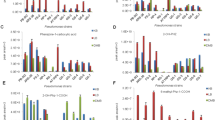Abstract
A new Pseudomonas strain, designated GP72, was isolated from green pepper rhizosphere and identified as a member of species Pseudomonas chlororaphis based on morphology; conventional biochemical and physiologic tests; Biolog GN system (Biolog Inc., Hayward, CA); and 16S rDNA sequence analysis. The secondary metabolites produced by this strain have shown broad-spectrum antifungal activity against various phytopathogens of agricultural importance in vitro. Two main antifungal substances produced by this strain proved to be phenazine-1-carboxylic acid and 2-hydroxyphenazine with further purification and structure elucidation based on ultraviolet-absorbent spectrum scanning, atmospheric pressure chemical ionization–mass spectrometry (APCI-MS) spectrum, and 1H,13C nuclear magnetic resonance spectrums. Strain GP72 could produce quorum-sensing signaling molecules of N-butanoyl-L-homoserine lactone and N-hexanoyl-L-homoserine lactone, which were found to accumulate with different quantities in King’s medium B and pigment producing medium, respectively.



Similar content being viewed by others
Literature Cited
Arima K, Imanaka H, Kousaka M, Fukuda A, Tamura G (1964) Pyrrolnitrin, a new antibiotic substance, produced by Pseudomonas. Agric Biol Chem 28:575–576
Ausubel FM, Brent R, Kingston RE, Moore DD, Seidman JG, Smith JA, et al. (eds) (1995) Short protocols in molecular biology. Wiley, New York, NY
Bauer AW, Kirby WMM, Sherris JC, Turck M (1966) Antibiotic susceptibility testing by a standardized single disk method. Am J Clin Pathol 45:493–496
Bergey D, John GH, Noel RK, Peter HAS (1994) Bergey’s manual of determinative bacteriology, 9th ed. Lippincott Williams & Wilkins: Philadelphia, PA
Bric JM, Bostock RM, Silverstone SE (1991) Rapid in situ assay for indoleacetic acid production by bacteria immobilized on nitrocellulose membrane. Appl Environ Microbiol 57:535–538
Cha C, Gao P, Chen Y-C, Shaw PD, Farrand SK (1998) Production of acyl-homoserine lactone quorum-sensing signals by gram-negative plant-associated bacteria. Mol Plant Microbe Interact 11:1119–1129
Chin-A-Woeng TFC, Bloemberg GV, Lugtenberg BJJ (2003) Phenazines and their role in biocontrol by Pseudomonas bacteria. New Phytol 157:503–523
Gurtler V, Stanisich VA (1996) New approaches to typing and identification of bacteria using the 16S–23S rDNA spacer region. Microbiology 142:3–16
Howell CR, Stipanovic RD (1980) Suppression of Pythium ultimum-induced damping of cotton seedlings by Pseudomonas fluorescens and its antibiotic, pyoluteorin. Phytopathology 70:712–715
Hu HB, Xu YQ, Cheng F, Zhang XH, Hur B (2005) Isolation and characterization of a new Pseudomonas strain produced both phenazine 1-carboxylic acid and pyoluteorin. J Microbiol Biotech 15:86–90
King EO, Ward MK, Raney DE (1954) Two simple media for demonstration of pyocyanin and fluorescein. J Lab Clin Med 44:301–307
Kluyver AJ (1956) Pseudomonas aureofaciens nov. spec. and its pigments. J Bacteriol 72:406–411
Kumar RS, Ayyadurai N, Pandiaraja P, Reddy AV, Venkateswarlu Y, Sakthivel OPN (2005) Characterization of antifungal metabolite produced by a new strain Pseudomonas aeruginosa PUPa3 that exhibits broad-spectrum antifungal activity and biofertilizing traits. J Appl Microbiol 98:145–154
Kumar S, Tamura K, Nei M (2004) MEGA3: Integrated software for molecular evolutionary genetics analysis and sequence alignment. Brief Bioinform 5:150–163
Liu HM, Dong DX, Peng HS, Zhang XH, Xu YQ (2006) Genetic diversity of phenazine- and pyoluteorin-producing pseudomonads isolated from green pepper rhizosphere. Arch Microbiol 185(2):91–98
Lorck H (1948) Production of hydrocyanic acid by bacteria. Physiol Plant 1:142–146
Marmur J, Doty P (1962) Determination of the base composition of deoxyribonucleic acid from its thermal denaturation temperature. J Mol Biol 5:109–118
Mavrodi DV, Ksenzenko VN, Bonsall RF, Cook RJ, Boronin AM, Thomashow LS (1998) A seven-gene locus for synthesis of phenazine-1-carboxylic acid by Pseudomonas fluorescens 2-79. J Bacteriol 180:2541–2548
McClean KH, Winson MK, Fish L, Taylor A, Chhabra SR, Camara M, et al. (1997) Quorum sensing and Chromobacterium violaceum: Exploitation of violacein production and inhibition for the detection of N-acylhomoserine lactones. Microbiology 143:3703–3711
Milagres AMF, Napoleão D, Machuca A (1999) Detection of siderophore production from several fungi and bacteria by modification of chrome azurol S (CAS) agar plate assay. J Microbiol Methods 37:1–6
Sakthivel N, Gnanamanickam SS (1987) Evaluation of Pseudomonas fluorescens for suppression of sheath-rot disease and for enhancement of grain yields in rice (Oryza sativa L). Appl Environ Microbiol 53:2056–2059
Shanahan P, O’Sullivan DJ, Simpson P, Glennon JD, O’Gara F (1992) Isolation of 2,4-diacetylphloroglucinol from a fluorescent pseudomonad and investigation of physiologic parameters influencing its production. Appl Environ Microbiol 58:353–358
Slininger PJ, Burkhead KD, Schisler DA, Bothast RJ (2000) Isolation, identification, and accumulation of 2-acetamidophenol in liquid cultures of the wheat take-all biocontrol agent Pseudomonas fluorescens 2-79. Appl Microbiol Biotechnol 54:376–381
Voisard C, Keel C, Haas D, Défago G (1989) Cyanide production by Pseudomonas fluorescens helps suppress black root rot of tobaccounder gnotobiotic conditions. EMBO J 8:351–358
Watson D, MacDermot J, Wilson R, Cole PJ, Taylor GW (1986) Purification and structural analysis of pyocyanin and 1-hydroxyphenazine. Eur J Biochem 159:309–313
Acknowledgments
We gratefully thank Dieter Haas for generously providing the plasmids and strains used in this study. This work was financially supported by Grant No. 2004BA308A02-14 from the 10th Five-Year Programs of Chinese National Science and Technology Development and Grant No. 30370041 from the National Science Foundation.
Author information
Authors and Affiliations
Corresponding author
Rights and permissions
About this article
Cite this article
Liu, H., He, Y., Jiang, H. et al. Characterization of a Phenazine-Producing Strain Pseudomonas chlororaphis GP72 with Broad-Spectrum Antifungal Activity from Green Pepper Rhizosphere. Curr Microbiol 54, 302–306 (2007). https://doi.org/10.1007/s00284-006-0444-4
Received:
Accepted:
Published:
Issue Date:
DOI: https://doi.org/10.1007/s00284-006-0444-4




